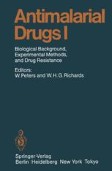Search
Search Results
-
Rodent Malaria Models
The first isolation of rodent malaria was reported by Vincke and Lips (1948). This isolate, obtained from the tree rat Thamnomys surdaster, was...
-
Malaria Models in Simian Hosts
Recognition by Moore and Lanier (1961) and Young and Moore (1961) of Plasmodium falciparum strains resistant to chloroquine, coupled with the disease...
-
Repository Preparations
The nature and extent of the malaria problem and the details surrounding those agents both available and under development for treatment of active...
-
Malaria Models in Simian Hosts
Recognition by Moore and Lanier (1961) and Young and Moore (1961) of Plasmodium falciparum strains resistant to chloroquine, coupled with the disease...
-
Antibiotics
The report by Hindle and his associates, in 1945, that penicillin exerted no effects against malaria was followed, 4 years later, by the disclosure...
-
Quinine and Quinine Analogues
Quinine, the oldest universally known antimalarial agent, has been the subject of numerous reviews in the past. We do not intend in this chapter to...
-
Malaria epidemiology
In this chapter it is not intended to give an account of the many factors governing malaria transmission since such a review has been provided in the...
-
Dihydrofolate Reductase Inhibitors
While exploring structural variations of anilinopyrimidines with antimalarial activity, a group at Imperial Chemical Industries found that certain...
-
Drugs with Quinine-like Action
The drugs to be discussed in this chapter all belong to the general chemical class arylaminoalcohols, and are related structurally to quinine. It is...
-
Clinical Trials — Phases I and II
The need for develo** new antimalarials has been expressed on various occasions by the World Health Organization (WHO). The “Special Programme for...
-
Clinical Trials — Phases I and II
The need for develo** new antimalarials has been expressed on various occasions by the World Health Organization (WHO). The “Special Programme for...
-
Inhibitors of Dihydrofolate Reductase as Antiprotozoal Agents
The therapeutic potential of inhibitors of dihydrofolate reductase as selectively toxic agents was first realized in early studies involving...
-
Treatment of Miscellaneous and Unusual Infections with Trimethoprim and Trimethoprim/Sulfonamide Combinations
The broad spectrum of in vitro antimicrobial activity and frequent observations of synergy with the combination of trimethoprim and sulfamethoxazole...
-
Sulfonamides: Structure-Activity Relationships and Mechanism of Action
The discovery of the antibacterial activity of prontosil (1) in the early 1930 s (Domagk 1935, 1957), the first effective chemotherapeutic agent to...
-
The Protozoa
Protozoans are an extremely diverse group of uni-cellular animals. As free-living organisms they are found in virtually every ecological niche, such...
-
Metabolites, enzymes, and metabolite analogues
The smallest change in the chemical constitution of a selectively toxic agent often makes an enormous change in its biological activity, and many...
-
The Treatment of Chloroquine-Resistant Falciparum Malaria
The severity of the falciparum infection is a much more important factor than its response to chloroquine.
-
Differences in distribution: the first principle of selectivity
Selectivity through distribution can take place even when the agent is toxic to both economic and uneconomic cells, provided that it is accumulated...
